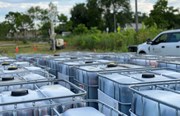7 Reasons to Use Thermal Technology on Your Next Brownfields Project Site
By: John LaChanceIn many cities, long neglected properties are getting snapped up for valuable redevelopment projects. However, there’s usually a reason those sites have been sitting unused—and that reason is often subsurface contamination. These brownfields projects have millions of dollars riding on them, and have tight schedules for transforming them into revenue generating properties. Whatever remediation approach is selected must be fast and effective.
In situ thermal remediation (ISTR) is one such technology. It is routinely used for aggressive and safe remediation of high mass/DNAPL source zones in urban areas, as exemplified by the successful fast-track clean-ups implemented at numerous sites around North America and the world.
For such time-sensitive remedies, a high degree of confidence in the technology is needed. In this blog post, I’ll cover seven reasons you can have that level of confidence when choosing thermal for your brownfields projects.
If you want a deeper dive, join me for next week's webinar, Fast, Reliable Remediation: Why Thermal Should Be On Your Short List for Redevelopment Projects. I'll be covering challenges specific to redevelopment projects, and share some real-life examples of work we've done. There will also be a Q&A at the end where I can answer your questions.
#1: Quick Results
Depending on the contaminants, site conditions and remedial goals, remediation times for thermal projects typically range from six to eight months. When you factor in the design phase, permitting, construction, operation/remediation, and demobilization, the project spans about 10 to 12 months.
Shorter project durations can be achieved for accelerated redevelopment by adding drilling capacity and construction labor, and by decreasing the spacing between the thermal remediation points to shorten the heat-up and remediation times. However, these options will result in increased costs.
#2: Proven Technology
ISTR has been successfully and safely implemented at more than 500 sites worldwide. Its efficacy in treating difficult high mass/DNAPL source zones in complex geologic settings has been well documented over the years in numerous papers. The EPA, USACE, and commercial enterprises rely on ISTR as the go-to approach for difficult sites with recalcitrant contaminants.
#3: Reliable Outcomes
ISTR has been proven to reliably achieve low to very low soil and groundwater cleanup goals at numerous sites for a wide range of contaminants. Typical goals that have been achieved include maximum contaminant levels (MCLs) for groundwater, and vapor intrusion and source to groundwater soil goals. ISTR is a remediation technology that predictably achieves these types of goals for a wide range of contaminants and site conditions. This capacity capability creates the most value for property owners and investors, as ISTR can achieve unrestricted use status for properties. This means the property can be redeveloped and reused as the owners see fit—there are no limits regarding residential and/or commercial use other than local zoning laws.
#4: Safe to Implement
Thermal remediation systems, if properly designed and implemented, do not pose unacceptable risks to on-site workers or surrounding residents. Unlike other source zone remediation technologies like excavation, ISTR does not require extensive use of heavy machinery or large numbers of trucks, or create large piles of exposed contaminated soil that may generate adverse odors and vapor concentrations.
Aside from easily manageable construction and operation activities, the soil and groundwater are remediated in place during ISTR projects.
#5: Cost Competitive
When compared with other rapid remediation options such as excavation and off-site disposal, ISTR can be very cost competitive. This is especially true if the contaminants are deep, below the water table, or below buildings where there are sensitive utilities requiring abandonment and relocation if excavation is implemented. Typical unit costs for thermal remediation of sites impacted with CVOCs ranges between $75 and $150/cy, depending on size, depth, volume, contaminant mass, site complexity/constraints, and remedial targets.
#6: Little Community Disruption
Unlike excavation and off-site disposal, ISTR does not require large numbers of vehicles or trucks, open excavations, and earth moving machinery. It also does not generate significant community traffic, odors, dust, or noise. ISTR has been safely and successfully implemented immediately adjacent and beneath occupied commercial and residential properties.
#7: No Long-Term Liability
Unlike excavation and off-site disposal, where liability still remains for the contaminants disposed of in a landfill, thermal remediation effectively removes the contaminants from the site and destroys them once and for all. There is no lingering long-term liability potential.
If you’d like to learn more about ISTR and how it works for brownfields redevelopment project, register for next week's webinar, Fast, Reliable Remediation: Why Thermal Should Be On Your Short List for Redevelopment Projects.
Other questions? Reach out to John LaChance at [email protected].
ABOUT THE AUTHOR

John LaChance
Vice President, Technology
[email protected]
John LaChance is the Vice President of Technology at TerraTherm, a Cascade Company. In his 30+ year career in the remediation industry, he’s worked on a range of project sites, including chemical manufacturing plants, gas stations, oil refineries, railroads, former MGP sites, solvent recycling facilities, grain and feed storage centers, and landfills. Most of these sites have focused on the assessment and cleanup of chlorinated solvents and other recalcitrant chemicals.
Those projects have taken him all over the world, to sites in Brazil, China, Australia, and several European countries. As an international expert on in situ thermal remediation (ISTR), John has led the charge for the development of innovative heating technologies, including identifying sustainable energy and geothermal techniques that can optimize thermal remedies with a smaller environmental footprint.
In his current role, John helps clients select thermal technologies that will meet regulatory requirements, eliminate liability, and enable the resale or reuse of their property. Having designed and implemented more than 50 in situ thermal remedies addressing a range of contaminants, John brings a wealth of technical and strategic insight to every project. His clients can rely on him and his team to safely achieve remedial targets on budget and on schedule.

